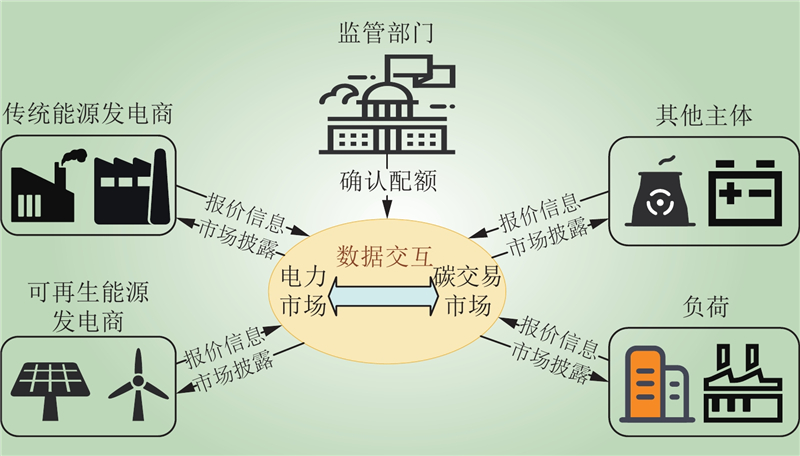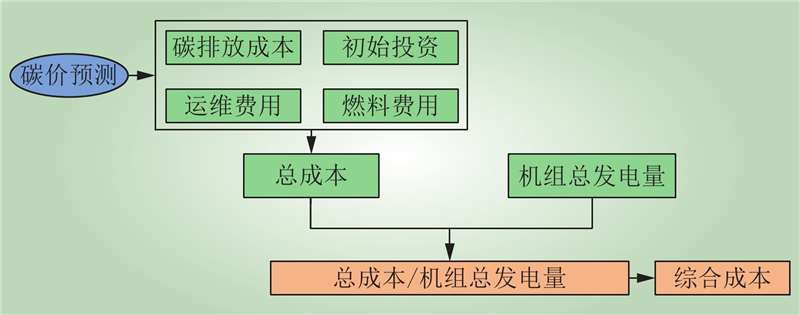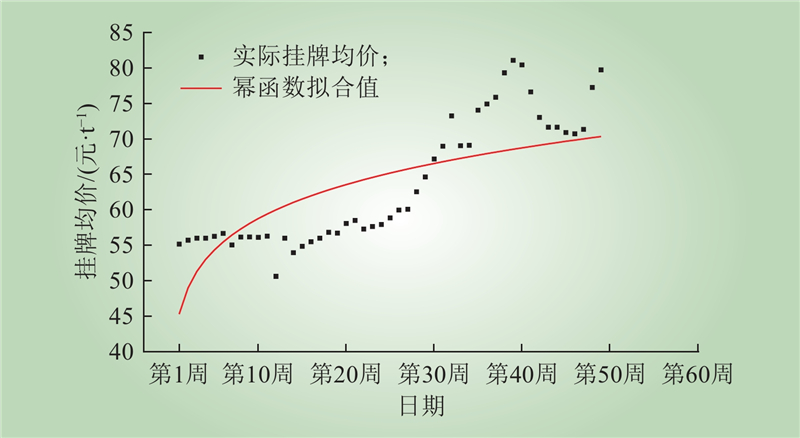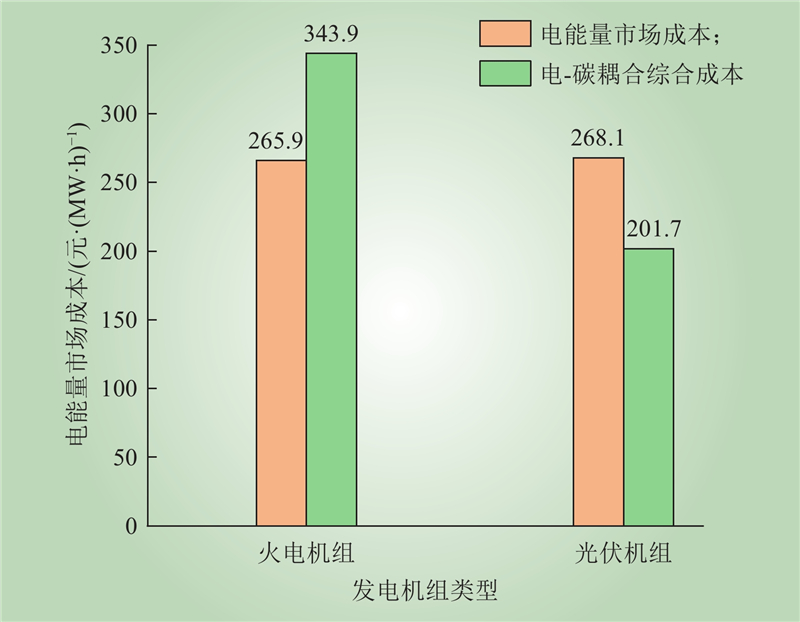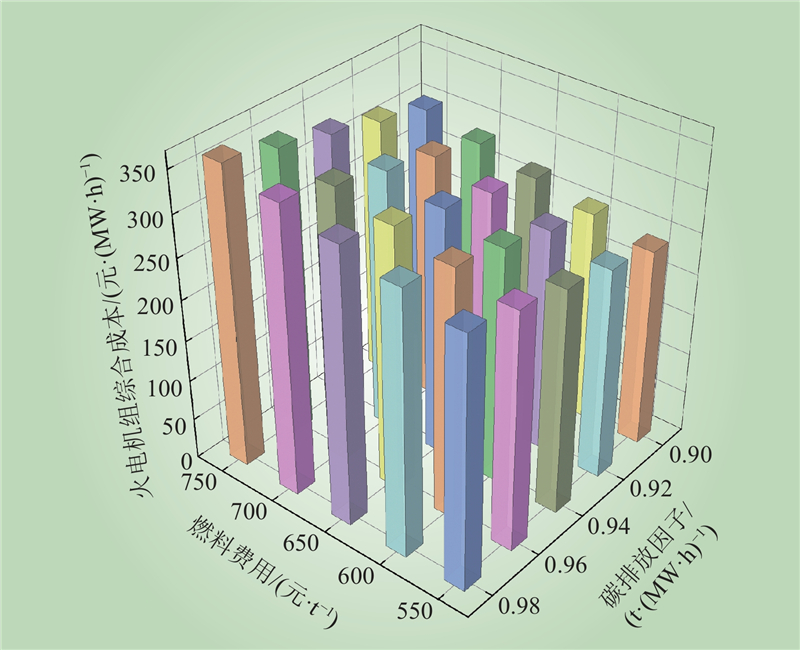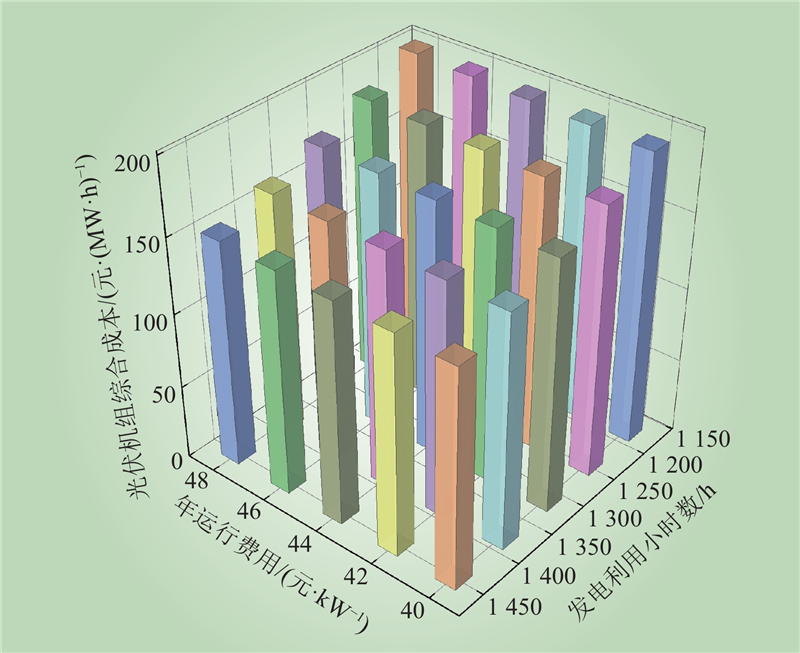| 1 |
何伊慧, 管霖, 王彤, 等. 南方电网新型电力系统规划建设的量化评估与分析[J]. 南方电网技术, 2024, 18 (10): 40- 53.
|
|
HE Yihui, GUAN Lin, WANG Tong, et al. Quantitative evaluation and analysis of planning and construction of the new power system in China southern power grid[J]. Southern Power System Technology, 2024, 18 (10): 40- 53.
|
| 2 |
邓盛盛, 陈皓勇, 肖东亮, 等. 考虑碳市场交易的寡头电力市场均衡分析[J]. 南方电网技术, 2024, 18 (1): 143- 152.
|
|
DENG Shengsheng, CHEN Haoyong, XIAO Dongliang, et al. Equilibrium analysis of oligopoly electricity market considering carbon market trading[J]. Southern Power System Technology, 2024, 18 (1): 143- 152.
|
| 3 |
徐若晨, 张江涛, 刘明义, 等. 电化学储能及抽水蓄能全生命周期度电成本分析[J]. 电工电能新技术, 2021, 40 (12): 10- 18.
DOI
|
|
XU Ruochen, ZHANG Jiangtao, LIU Mingyi, et al. Analysis of life cycle cost of electrochemical energy storage and pumped storage[J]. Advanced Technology of Electrical Engineering and Energy, 2021, 40 (12): 10- 18.
DOI
|
| 4 |
刘阳, 滕卫军, 谷青发, 等. 规模化多元电化学储能度电成本及其经济性分析[J]. 储能科学与技术, 2023, 12 (1): 312- 318.
|
|
LIU Yang, TENG Weijun, GU Qingfa, et al. Scaled-up diversified electrochemical energy storage LCOE and its economic analysis[J]. Energy Storage Science and Technology, 2023, 12 (1): 312- 318.
|
| 5 |
蓝澜, 刘强, 陈梓, 等. 新能源比传统能源成本更高吗?——基于LCOE方法的中国风电与火电成本比较[J]. 西部论坛, 2013, 23 (3): 66- 72.
|
|
LAN Lan, LIU Qiang, CHEN Zi, et al. Is the cost of renewable energy higher than traditional energy?——comparison of the cost between wind power and heat power in China based on LCOE[J]. West Forum, 2013, 23 (3): 66- 72.
|
| 6 |
聂洪光, 刘尚奇, 莫建雷. 补贴“退坡” 背景下可再生能源发电激励政策及发展路径研究: 基于拓展的平准化度电成本模型[J]. 中国地质大学学报(社会科学版), 2022, 22 (6): 66- 81.
|
|
NIE Hongguang, LIU Shangqi, MO Jianlei. Incentive policies and development path of China’s renewable energy power under the background of declining subsidy: a study using comprehensive levelized cost of electricity (CLCOE) model[J]. Journal of China University of Geosciences (Social Sciences Edition), 2022, 22 (6): 66- 81.
|
| 7 |
吴琪, 赵宣茗, 张佳诚, 等. 促进新能源消纳的电-碳市场耦合激励型出清机制[J]. 电力建设, 2023, 44 (12): 14- 27.
DOI
|
|
WU Qi, ZHAO Xuanming, ZHANG Jiacheng, et al. Electricity-carbon market coupling incentive clearing mechanism to promote consumption of new energy[J]. Electric Power Construction, 2023, 44 (12): 14- 27.
DOI
|
| 8 |
LI Z H, FANG T, CHEN C. Research on environmental cost fromthe perspective of coal-fired power plant[J]. Polish Journal of Environmental Studies, 2021, 30 (2): 1695- 1705.
DOI
|
| 9 |
贾亚雷, 王继选, 韩中合, 等. 基于LCA的风力发电、光伏发电及燃煤发电的环境负荷分析[J]. 动力工程学报, 2016, 36 (12): 1000- 1009.
|
|
JIA Yalei, WANG Jixuan, HAN Zhonghe, et al. Analysis on environmental load of wind, PV and coal-fired power generation based on life cycle assessment[J]. Journal of Chinese Society of Power Engineering, 2016, 36 (12): 1000- 1009.
|
| 10 |
张慧敏, 李晏, 冯天天, 等. 碳中和背景下跨省电力交易空间结构及影响因素研究[J]. 智慧电力, 2022, 50 (11): 56- 61.
DOI
|
|
ZHANG Huimin, LI Yan, FENG Tiantian, et al. Spatial structure and influencing factors of inter-provincial power transaction under carbon neutralization[J]. Smart Power, 2022, 50 (11): 56- 61.
DOI
|
| 11 |
吴鸿亮, 刘羽霄, 张宁, 等. 南方电网西电东送中的碳交易模型及其效益分析[J]. 电网技术, 2017, 41 (3): 745- 751.
|
|
WU Hongliang, LIU Yuxiao, ZHANG Ning, et al. Carbon trading models and benefit analysis in CSG west-to-east power transmission[J]. Power System Technology, 2017, 41 (3): 745- 751.
|
| 12 |
董福贵, 郗来昊, 孟子航. 考虑碳交易的电力现货市场出清多阶段优化模型研究[J]. 电网技术, 2024, 48 (1): 79- 96.
|
|
DONG Fugui, CHI Laihao, MENG Zihang. Multi-stage optimization model for electricity spot market clearing considering carbon trading[J]. Power System Technology, 2024, 48 (1): 79- 96.
|
| 13 |
CHONG S J, WU J, CHANG I S. Cost accounting and economic competitiveness evaluation of photovoltaic power generation in China: based on the system levelized cost of electricity[J]. Renewable Energy, 2024, 222, 119940.
DOI
|
| 14 |
王蕊. 我国碳金融市场中碳交易价格的影响因素分析: 基于面板分位数模型[D]. 西安: 西北大学, 2021.
|
|
WANG Rui. The research on the infulence factors of carbon emission price in China-empirical study based on the panel quantile model[D]. Xi’an: Northwest University, 2021.
|
| 15 |
王娜. 基于大数据的碳价预测[J]. 统计研究, 2016, 33 (11): 56- 62.
|
|
WANG Na. Forecasting of carbon price based on big data[J]. Statistical Research, 2016, 33 (11): 56- 62.
|
| 16 |
秦全德, 黄兆荣, 黄凯珊. 一种基于局部回归的多尺度碳市场价格预测模型研究[J]. 运筹与管理, 2022, 31 (1): 107- 114.
|
|
QIN Quande, HUANG Zhaorong, HUANG Kaishan. A multi-scale carbon price forecasting model withLocal regression approach[J]. Operations Research and Management Science, 2022, 31 (1): 107- 114.
|
| 17 |
DONG H W, HU Y, YANG Y H, et al. A multi-strategy integration prediction model for carbon price[J]. Energies, 2023, 16 (12): 4613.
DOI
|
| 18 |
王科, 李思阳. 中国碳市场回顾与展望(2022)[J]. 北京理工大学学报(社会科学版), 2022, 24 (2): 33- 42.
|
|
WANG Ke, LI Siyang. China’s carbon market: reviews and prospects(2022)[J]. Journal of Beijing Institute of Technology (Social Sciences Edition), 2022, 24 (2): 33- 42.
|
| 19 |
王一蓉, 陈浩林, 林立身, 等. 考虑电力行业碳排放的全国碳价预测[J]. 中国电力, 2024, 57 (5): 79- 87.
|
|
WANG Yirong, CHEN Haolin, LIN Lishen, et al. National carbon price prediction considering carbon emissions from the power industry[J]. Electric Power, 2024, 57 (5): 79- 87.
|
| 20 |
上海环境能源交易所[EB/OL]. https://www.cneeex.com/.
|
| 21 |
严涛, 江开忠, 姜新盈, 等. 基于高斯混合聚类采样的不平衡数据处理方法[J]. 计算机应用与软件, 2023, 40 (12): 305- 311.
DOI
|
|
YAN Tao, JIANG Kaizhong, JIANG Xinying, et al. Unbalanced data processing method based on Gaussian mixture clustering[J]. Computer Applications and Software, 2023, 40 (12): 305- 311.
DOI
|
| 22 |
王强, 张津, 李上杨. 抗噪性高斯过程用于风电系统暂态电压稳定性的评估[J]. 南方电网技术, 2024, 18 (9): 126- 137.
|
|
WANG Qiang, ZHANG Jin, LI Shangyang. Transient voltage stability assessment of wind power system based on noisy input multi-class gaussian process[J]. Southern Power System Technology, 2024, 18 (9): 126- 137.
|
| 23 |
李丹, 梁云嫣, 缪书唯, 等. 基于高斯混合聚类和改进条件变分自编码的多风电场功率日场景生成方法[J]. 中国电力, 2024, 57 (12): 17- 29.
|
|
LI Dan, LIANG Yunyan, MIAO Shuwei, et al. Daily power scenario generation method for multiple wind farms based on Gaussian mixture clustering and improved conditional variational autoencoder[J]. Electric Power, 2024, 57 (12): 17- 29.
|
| 24 |
房玉杰, 张松, 刘晋, 等. 基于高斯混合模型的脚步声身份识别方法[J]. 计算机应用, 2021, 41 (S2): 221- 225.
|
|
FANG Yujie, ZHANG Song, LIU Jin, et al. Footstep identification method based on Gaussian mixture model[J]. Journal of Computer Applications, 2021, 41 (S2): 221- 225.
|
| 25 |
RUAN L Y, YUAN M, ZOU H. Regularized parameter estimation in high-dimensional Gaussian mixture models[J]. Neural Computation, 2011, 23 (6): 1605- 1622.
DOI
|
| 26 |
XIA R, ZHANG Q Y, DENG X Y. Multiscale Gaussian convolution algorithm for estimate of Gaussian mixture model[J]. Communications in Statistics - Theory and Methods, 2019, 48 (23): 5889- 5910.
DOI
|
| 27 |
保定市-满城区建设热电厂二期项目[EB/OL]. (2023-11-01) [2023-12-27]. http://www.hebpi.com/xmk/403507.
|
| 28 |
石家庄市-经济技术开发区建设高速沿线分布式光伏项目[EB/OL]. (2023-12-26) [2023-12-27]. http://www.hebpi.com/xmk/414208.
|
| 29 |
陈巍, 江岳文. 碳-绿证-电量市场耦合交易优化研究[J]. 电网技术, 2023, 47 (6): 2273- 2287.
|
|
CHEN Wei, JIANG Yuewen. Trading optimization of carbon-green certificate-electricity market coupling[J]. Power System Technology, 2023, 47 (6): 2273- 2287.
|
| 30 |
《2019-2020年全国碳排放权交易配额总量设定与分配实施方案 (发电行业)》[Z]. 2020.
|
| 31 |
MORRIS M D. Factorial sampling plans for preliminary computational experiments[J]. Technometrics, 1991, 33 (2): 161- 174.
DOI
|
| 32 |
中矿(北京)煤炭产业景气指数研究课题组. 2022—2023年中国煤炭产业经济形势研究报告[J]. 中国煤炭, 2023, 49 (3): 2- 10.
|
|
Research Group of Zhongkuang (Beijing) Coal Industry Prosperity Index. Research report on the economic situation of China’s coal industry from 2022 to 2023[J]. China Coal, 2023, 49 (3): 2- 10.
|
| 33 |
张彩庆, 史惠卿, 郑楠. 计及碳交易和碳税的碳捕集技术经济性研究[J]. 动力工程学报, 2023, 43 (6): 787- 795.
|
|
ZHANG Caiqing, SHI Huiqing, ZHENG Nan. Techno-economic analysis of coal-fired plant integrated carbon capture and storage considering carbon trading and carbon tax[J]. Journal of Chinese Society of Power Engineering, 2023, 43 (6): 787- 795.
|
| 34 |
MORRIS J, KHESHGI H, PALTSEV S, et al. Scenarios for the deployment of carbon capture and storage in the power sector in a portfolio of mitigation options[J]. Climate Change Economics, 2021, 12 (1): 2150001.
DOI
|
| 35 |
朱明亮. 中国电力能源替代经济性及路径研究[D]. 北京: 华北电力大学, 2021.
|
|
ZHU Mingliang. Study on ecnomy and path of China’s electric power energy substitution[D]. Beijing: North China Electric Power University, 2021.
|
| 36 |
刘录清, 余云川, 高银霞. 基于实物期权的光伏电站项目LCOE分析[J]. 太阳能, 2023, (10): 12- 20.
|
|
LIU Luqing, YU Yunchuan, GAO Yinxia. LCOE analysis of PV power station projects based on real options[J]. Solar Energy, 2023, (10): 12- 20.
|
| 37 |
全国各省市光伏电站最佳安装倾角、发电量、年有效利用小时数速查表[EB/OL](2021-8-24)[2023-12-27]https://guangfu.bjx.com.cn/news/20210824/1172006.shtml.
|
| 38 |
肖黎明. 设备衰减率对太阳能光伏发电利用小时数的影响分析[J]. 华电技术, 2017, 39 (12): 67- 69, 72, 76.
|
|
XIAO Liming. Impact analysis of equipment attenuation rate to the PV power generating equipment availability hour[J]. Huadian Technology, 2017, 39 (12): 67- 69, 72, 76.
|
| 39 |
马月, 吕永刚, 吴琼, 等. 山地光伏电站光伏组件阴影遮挡技改方案的经济性分析[J]. 太阳能, 2023, (10): 69- 74.
|
|
MA Yue, LYU Yonggang, WU Qiong, et al. Economic benefit analysis of shadow shading technology transformation for mountain PV power stations[J]. Solar Energy, 2023, (10): 69- 74.
|


